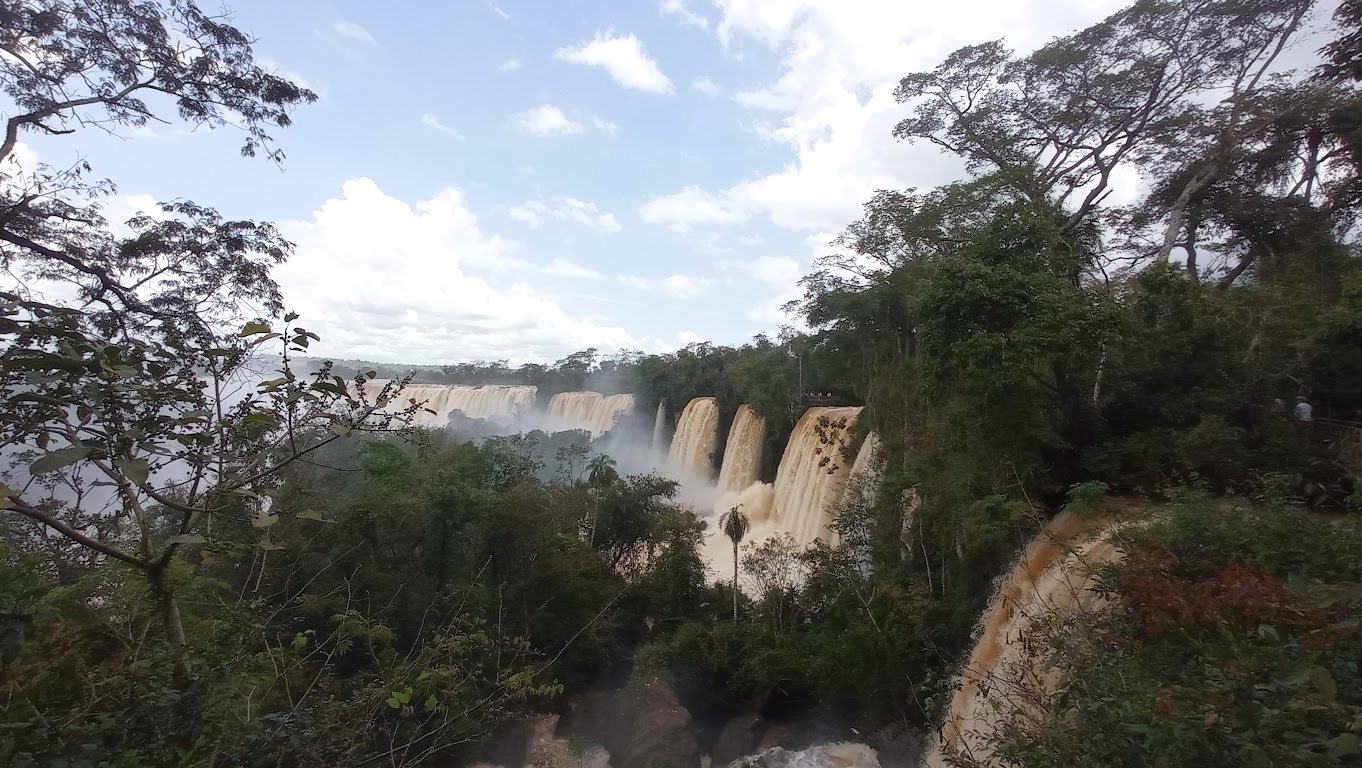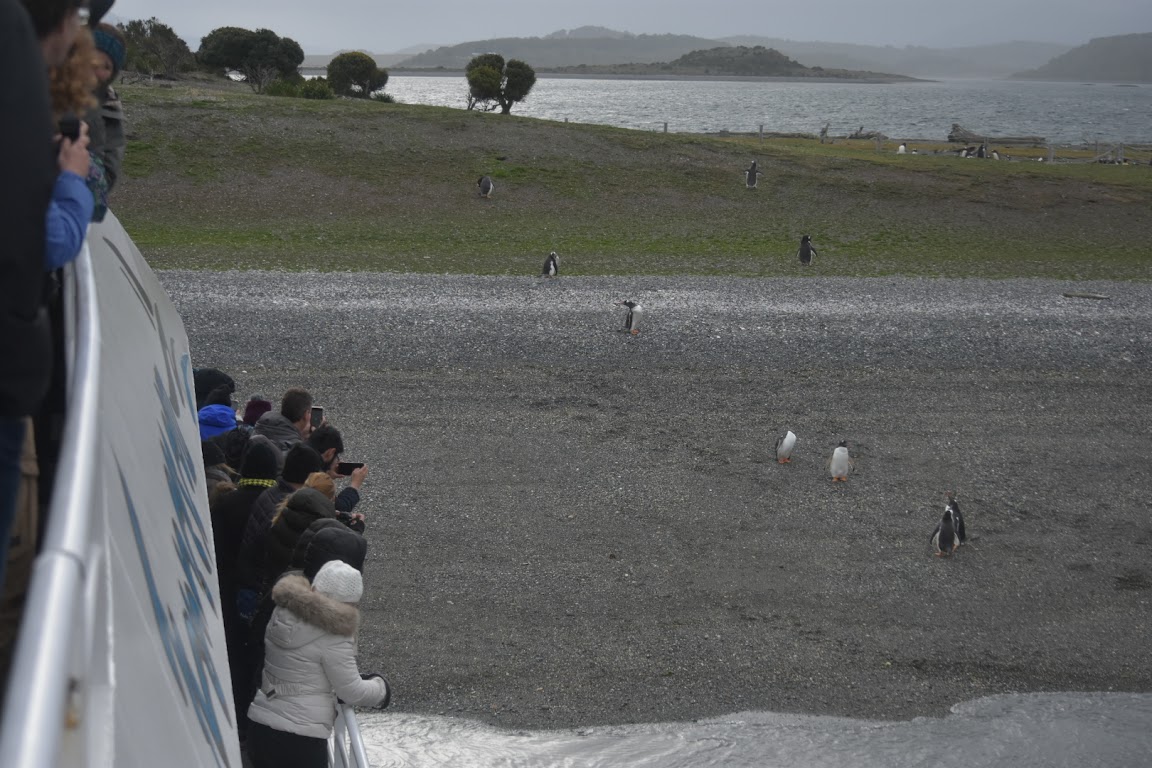Peninsula Valdes and Puerto Piramides – A backpacker’s guide
Contents
- Where is Peninsula Valdes?
- How to get to Peninsula Valdes and where to go
- What animals can be seen on Peninsula Valdes?
- What’s whale watching from Puerto Piramides like?
- Where to stay in Puerto Piramides
- Where to eat in Puerto Piramides
- Getting to Peninsula Valdes from Puerto Madryn
- Getting around Peninsula Valdes (+ How to get to Orca sites)
Where is Peninsula Valdes?
Located a thousand kilometers south of Buenos Aires, Peninsula Valdes on a map interrupts Argentina’s otherwise smooth-looking coastline. This nobble of land marks the start of Argentinian Patagonia, and while it lacks the jaw-dropping scenery this region is well known for, its collection of wildlife more than makes up for this.
How to get to Peninsula Valdes and where to go
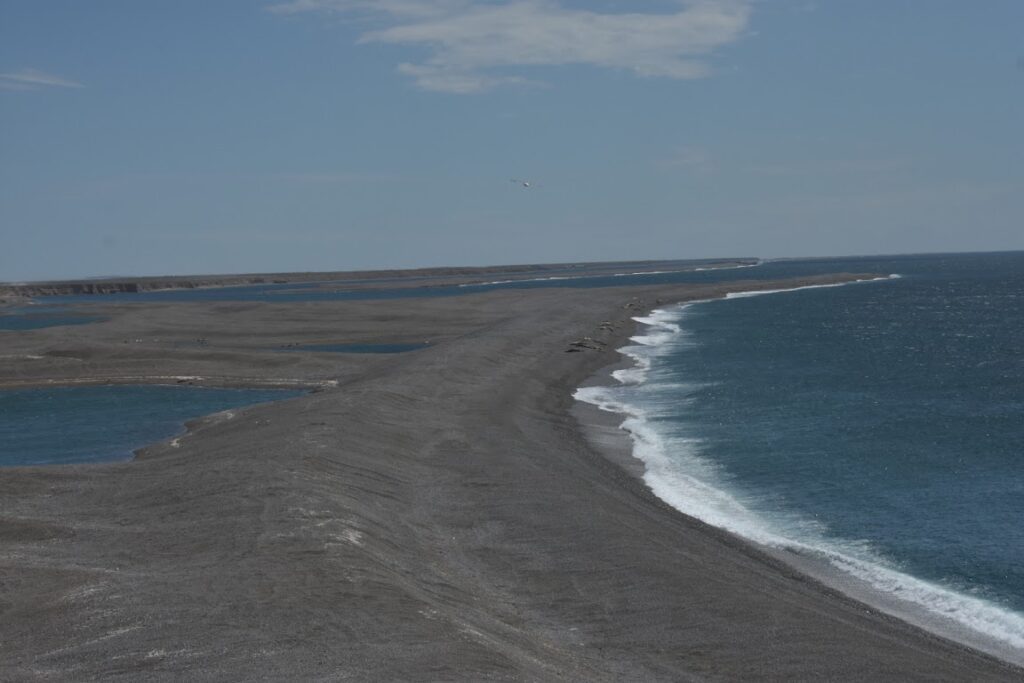
Peninsula Valdes was formed from two neighbouring bays almost meeting, giving it a round, bulbous, shape. It’s almost an island, and may well be one day on a geologist’s timeline, but for the time being a narrow strip of land allows for easy access from the rest of Argentina.
The closest cities are Puerto Madryn and Trelew, both of which have good flight and bus connections to the rest of the country. Note that Argentina is huge, so if you plan to travel overland you may be doing so for some time.
That fact also applies to Peninsula Valdes: while it may look small on a map, driving around it without stopping (and with all its wildlife and viewpoints, you wouldn’t want to) could easily take half a day. Indeed, when heading in, you’ll likely have a moment of “are we there yet?”
Peninsula Valdes’ entrance is located at the western end of the stretch of land that connects it to the mainland, while at the eastern end is the gateway town of Puerto Piramides. Puerto Piramides has the only lodgings on the entire peninsula, small shops and a central area where one can find five different whale-watching agencies clustered together. Branching out from it are a couple of trails; the eastward one goes along the clifftops and through some sand dunes, while the westward one goes through the hills to a pair of miradors (viewpoints). One of these looks down onto a sea lion colony, and both are good places for spotting whales if the time is right. Nearby is the junction where all the roads circumnavigating the peninsula meet.
To be quite frank, the scenery away from the coast is nothing to write home about. Most of Peninsula Valdes is flat and dominated by miles of shrubs and dust, a far cry from the jaw-dropping landscapes of Ushuaia and Bariloche. A few things of interest do pop up every now and then, though: herds of guanacos, small groups of maras and saline lakes that turn pink in the midday sun. One of these, Salina Grande, is also the lowest point in South America, at 40 metres below sea level.
At the northern end of the east coast is the aptly named Punta Norte, at the southern is Punta Delgada and pretty much in between is Caleta Valdes and Punta Cantor. These are home to colonies of sea lions, elephant seals and penguins, animals which in turn attract predatory orcas.
What animals can be seen on Peninsula Valdes?
Southern Right Whale
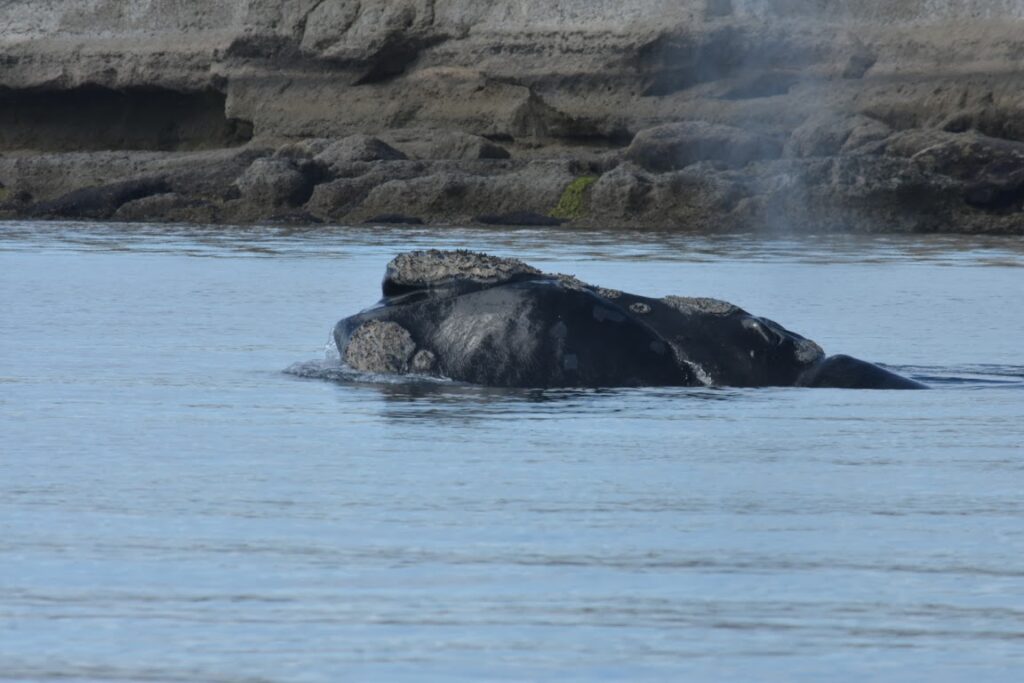
Southern right whales got their name from whalers. Inquisitive towards boats and often lingering about at the surface for lengthy time periods, they were the “right” whales to hunt. Legislation saved them from extinction before it was too late, and nowadays their friendly nature has made them a top tourist draw around here. They congregate in Golfo Nuevo to give birth to their calves, sheltered from the raging waters of the Atlantic. The best way to see them is by taking a boat trip out of Puerto Piramides (more on that in this section), but you can also see them near Puerto Piramides’ coast. Hike up to Mirador de las Ballenas for the best views.
Chances of spotting them: 10/10, unless they haven’t arrived yet. They come here from June-December, so the window in which to spot them is quite wide. The waters of Golfo Nuevo are generally flat calm, making it easy to spot their backs breaking the surface and their water spouts.
Orcas
Fun fact about me: The Trials of Life, a David Attenborough documentary in which orcas beach themselves to hunt sea lions, was the first one I ever watched, at the ripe old age of seven. Needless to say, I learned early on that nature can be brutal. In any case, Peninsula Valdes is where this extraordinary sequence was filmed. The orca patrols the shoreline, looking for any sea lions sitting close enough to the water’s edge. Target acquired, it launches itself onto land, grabbing the unfortunate sea lion in its jaws and thrashing its body to get back into the water. This is the only example of a cetacean deliberately beaching itself, and being able to get back into the sea thereafter.
Chances of spotting them: 6/10. They tend to beach at Punta Cantor between the months of October and November, but even then spotting them can be a matter of luck and patience.
Mara
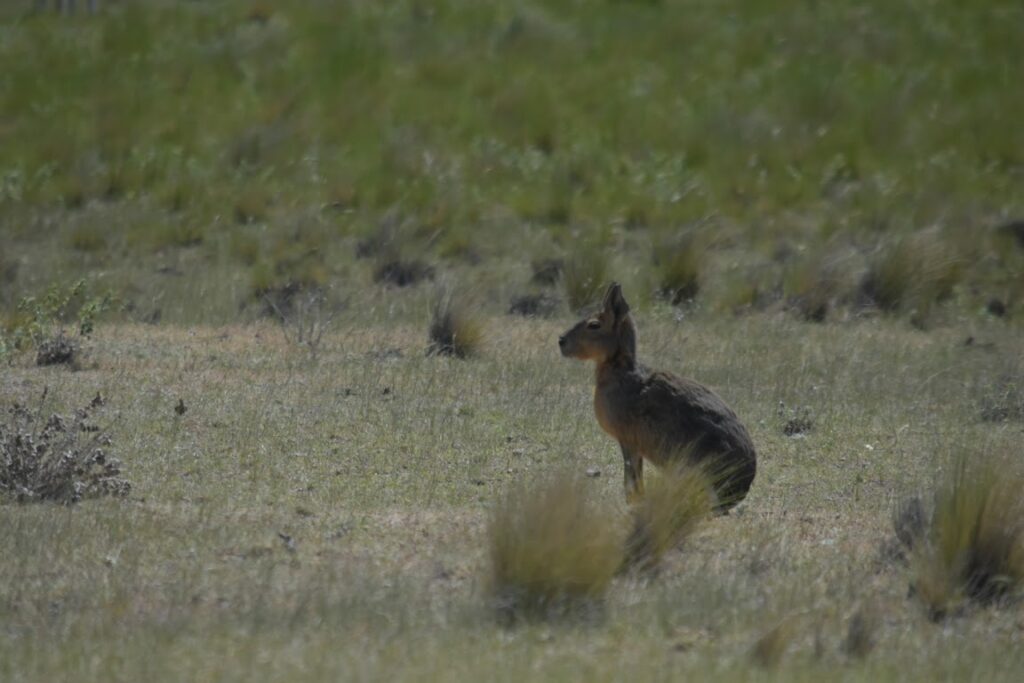
Also known as Patagonian cavies, these rodents are (as their name suggests) relatives of guinea pigs. Their long legs and height help them run away when faced with danger, bounding away like a llama. Maras are endemic to the flat plains of Argentina, and as a result, they were one of my personal top targets when visiting Peninsula Valdes. They can usually be found in open fields, and a particularly good spot for them is the junction between all of Peninsula Valdes’ roads just north of Puerto Piramides.
Chances of spotting them: 7.5/10. This rodent’s large size and diurnal behaviour mean it can generally be found sitting around in sheep fields. Furthermore, only young maras live in burrows. The adults are too large, and so rely on running away if spooked.
Magellanic penguin
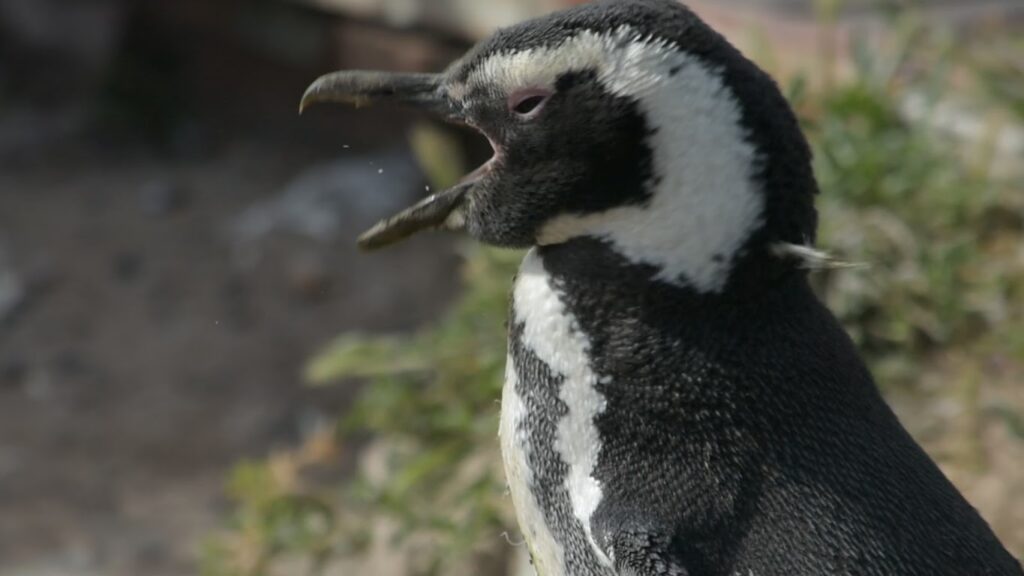
This penguin species nests all around the Patagonian coastline, from Peninsula Valdes to central Chile’s shores, and ventures north to Peru and Brazil when breeding season is over. It nests in small colonies, and primarily in burrows to protect chicks from predators and rough weather. Most of its colonies are along the east coast, with the largest at Punta Norte and a smaller one on the way to Punta Cantor.
Chances of spotting them: 10/10 if you visit their colonies during the breeding season. I also saw some isolated individuals floating about on my whale watching trip.
South American Sea Lion + Elephant seal
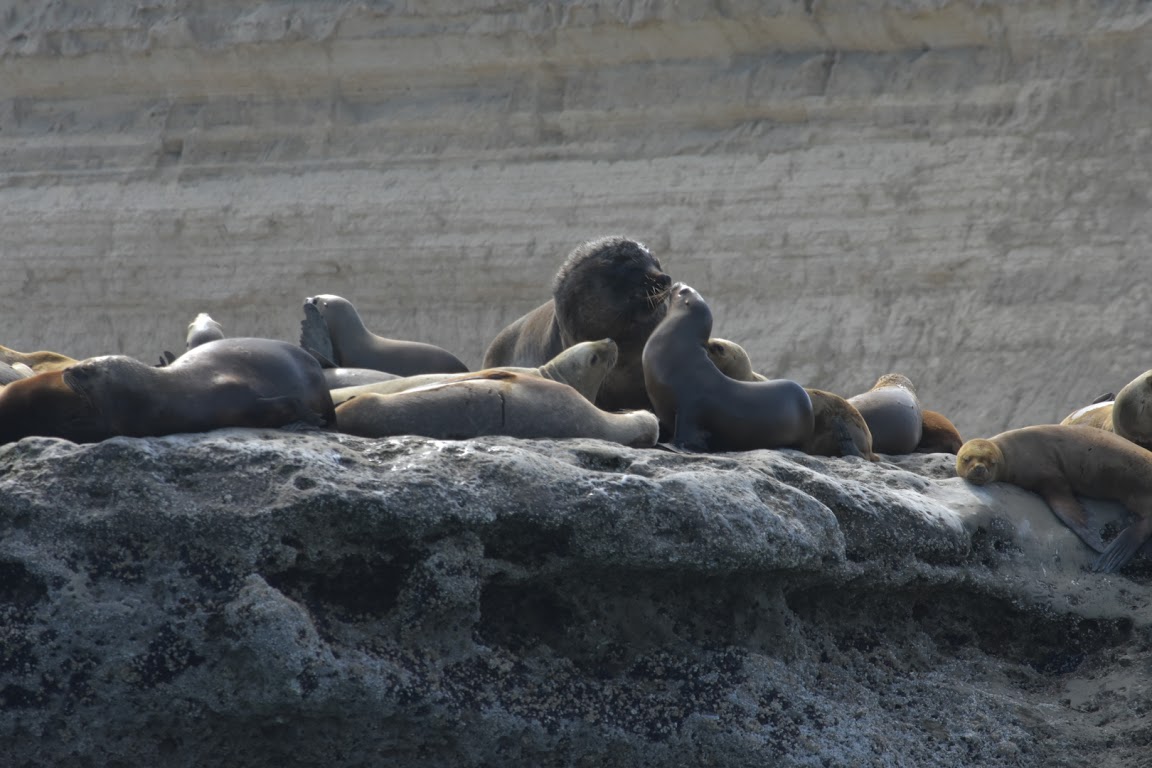
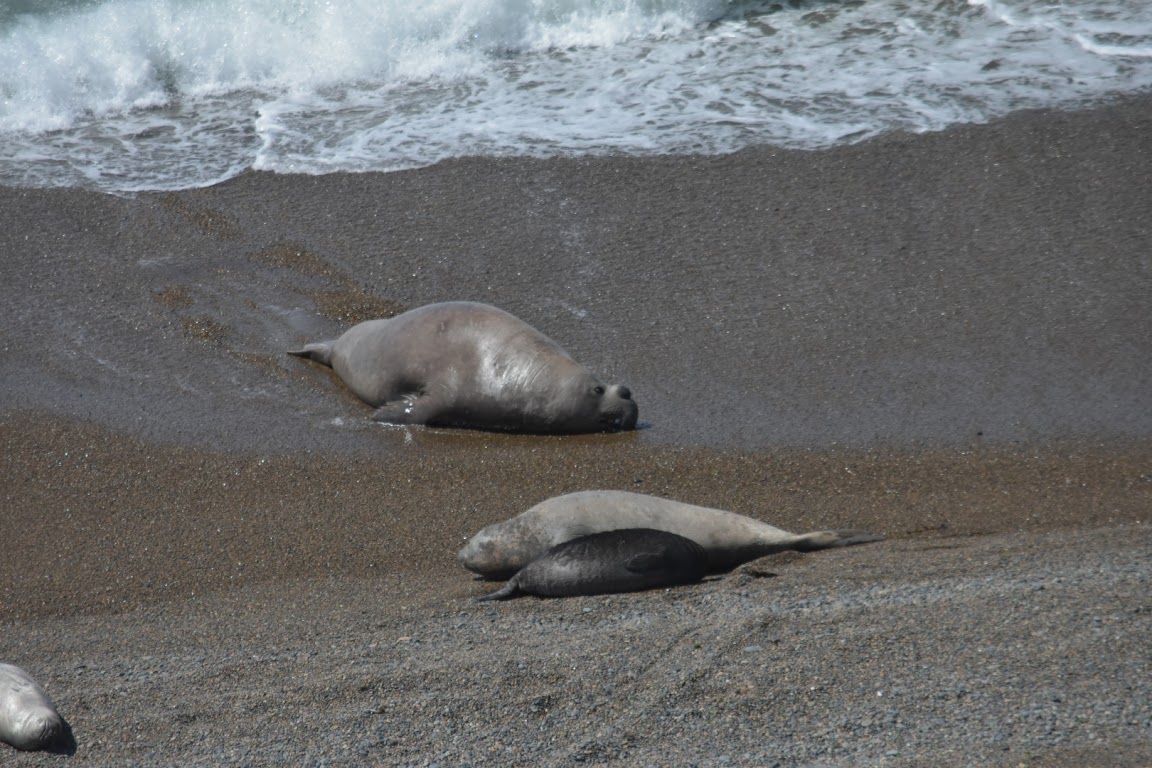
These two members of the phinniped family have huge colonies on Peninsula Valdes’ east coast, along with a small sea lion colony just outside Puerto Piramides. Both live in harems, in which groups of females are guarded by a single dominant male, who fights rival males for breeding rights. Among both species, the males’ appearance makes them worthy of their species’ names. The male sea lion has a mane, while the male elephant seal has a large, trunk-like nose and weighs up to 4,500 pounds.
Chances of spotting them: 10/10 if you visit one of their colonies. Sea lions can also be seen at the pier in Puerto Madryn.
Guanaco
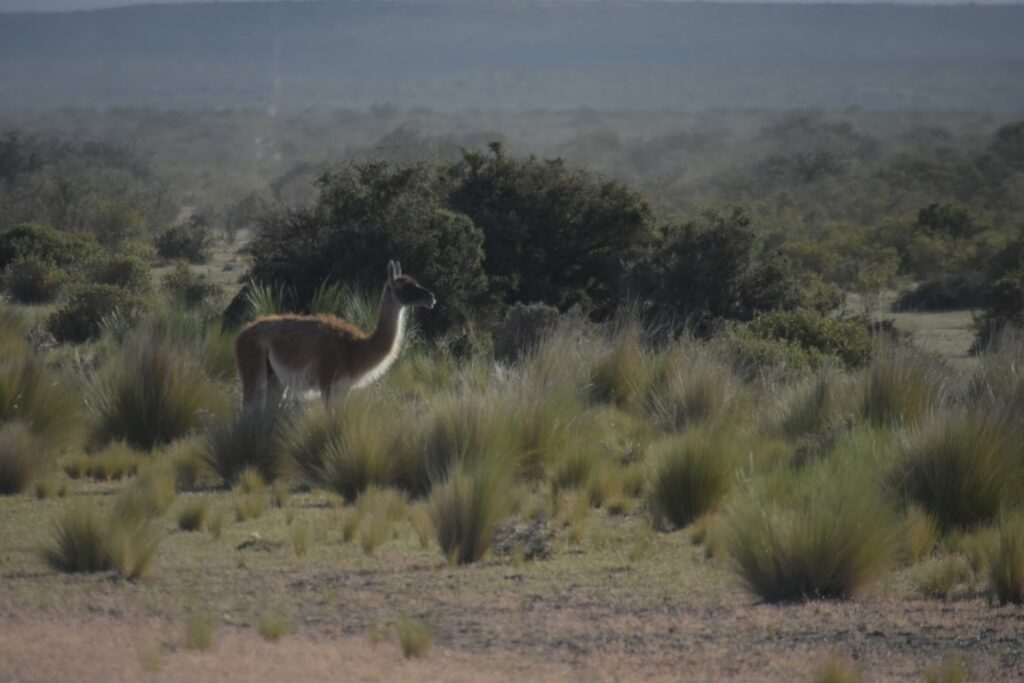
The llama’s wild ancestor can be found here in the hundreds, due to a near-absence of pumas, the guanaco’s only predator. Guanacos primarily live in herds of up to twenty individuals, and like the sea lions and elephant seals they are led by a dominant male. You’ll also likely see isolated bachelor males, since male calves are exiled from the herd by dominant males once they reach a year of age.
Chances of spotting them: 10/10. There are hundreds all over the peninsula.
Patagonian hog-nosed skunk
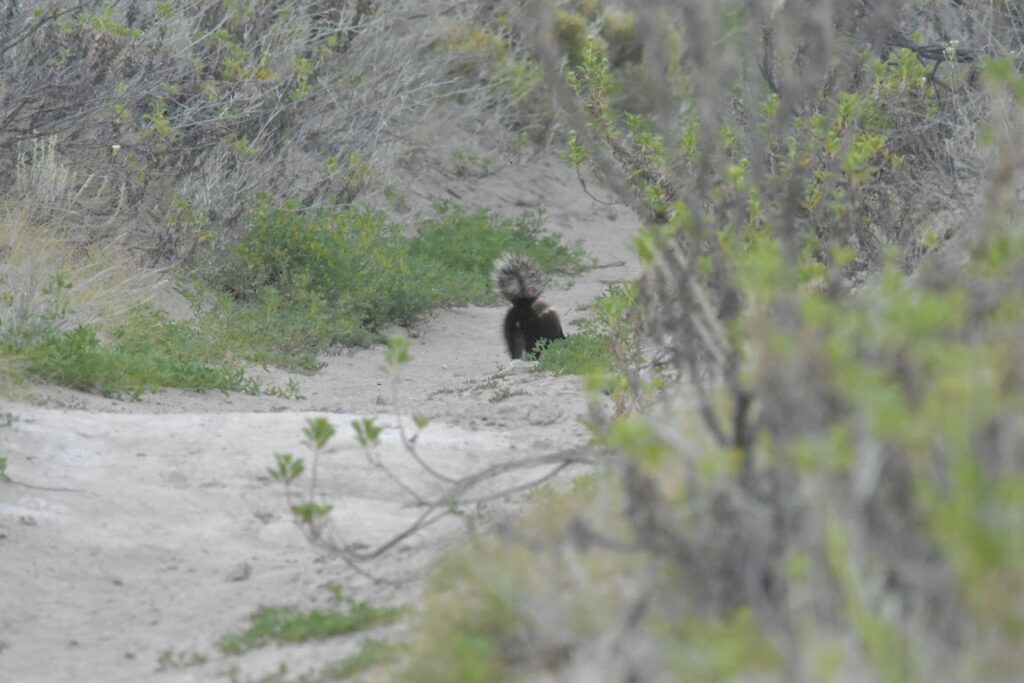
Like all members of the skunk family, this little animal omits a foul odour when it feels threatened, distorting predators and giving it a chance to run away. It’s mainly active at dawn and dusk, primarily feeding on insects but also eating any rodents it happens to come across.
Chances of spotting them: 6/10. Walk the trails around Puerto Piramides at dawn or dusk for the best chance, but take care not to surprise one – that would likely not end well. There’s also a decent chance of seeing one while driving around the peninsula.
Large hairy armadillo
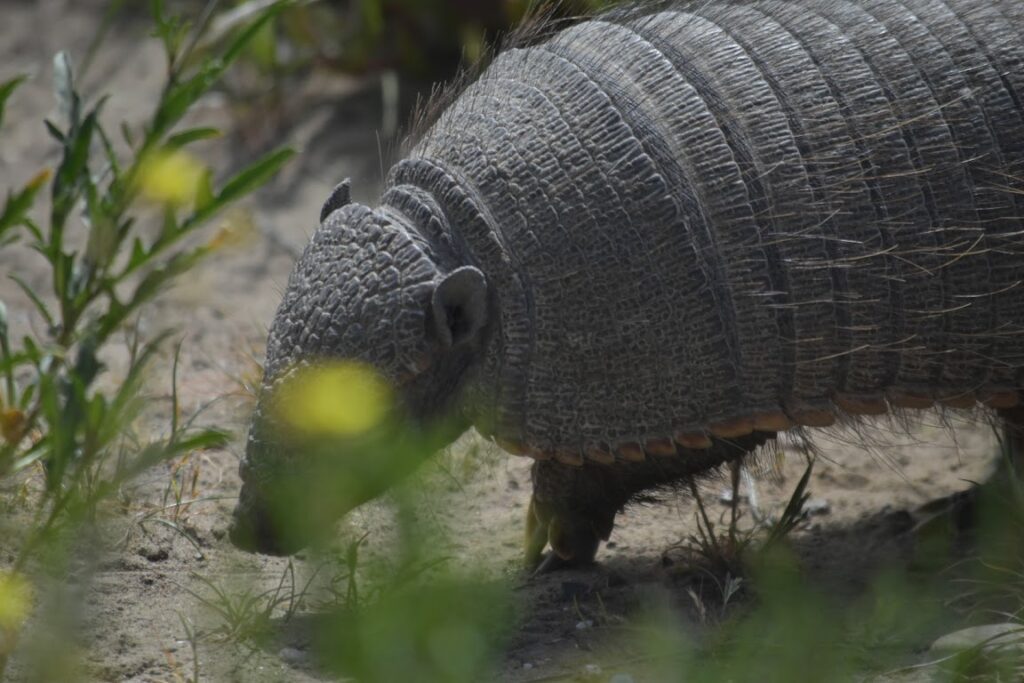
This armoured animal can often be seen ambling around the boardwalks at Caleta Valdes, by any visitors who happen to tear themselves from looking out for orcas. I, rather coincidentally, saw one approaching me as I was reading an information sign about them. Although it got quite close, it didn’t hang about. Armadillos used to hang around Caleta Valdes’ car park, looking for scraps, but it would appear that this is no longer the case, perhaps due to park rangers discouraging feeding them.
Chances of spotting them: 7/10. Hang around Punta Cantor for a while and search the trails behind the elephant seal viewing platfroms for the best chance.
Southern Mountain Cavy
This wild ancestor of the guinea pig is often found around Caleta Valdes, where a family has made a warren. Like rabbits, southern mountain cavies live in extensive networks of burrows, with multiple entrances and living quarters.
Chances of spotting them: 7/10. Search the grounds around Punta Cantor’s viewing platform, since there is a warren here.
What’s whale watching from Puerto Piramides like?
Whale-watching trips are not cheap – even with blue dollar rates, they go for £45. There’s little point in shopping around, since they cost the same at every agency. Despite that, it’s worth it to see fifteen metres of blubber peeking above the surface within selfie distance. Right whales, despite centuries of hunting and the fact that five agencies, each doing four tours per day, haven’t lost their curious nature in the slightest. Ethics and the whales’ welfare are important for these tours: at the start they’ll emphasise to visitors the importance of not making too much noise, and they cut the boat’s engines once they get to within 200 metres. Agencies are located near the roundabout with a whale tail statue, and generally accept cards (though, this being Argentina, you’ll want to pay cash for blule dollar rates). You start off getting kitted up in lifejackets, board a boat waiting on a trailer and get pushed out to sea by a tractor. The boat heads out, and you likely won’t go too far before spotting whales. On the way back, the boat will also stop at the sea lion colony, giving you an eye-level view of these animals.
Out of the whales’ breeding season, there’s little point in taking one of these tours unless you’re really keen to see the sea lions up close.
Where to stay in Puerto Piramides
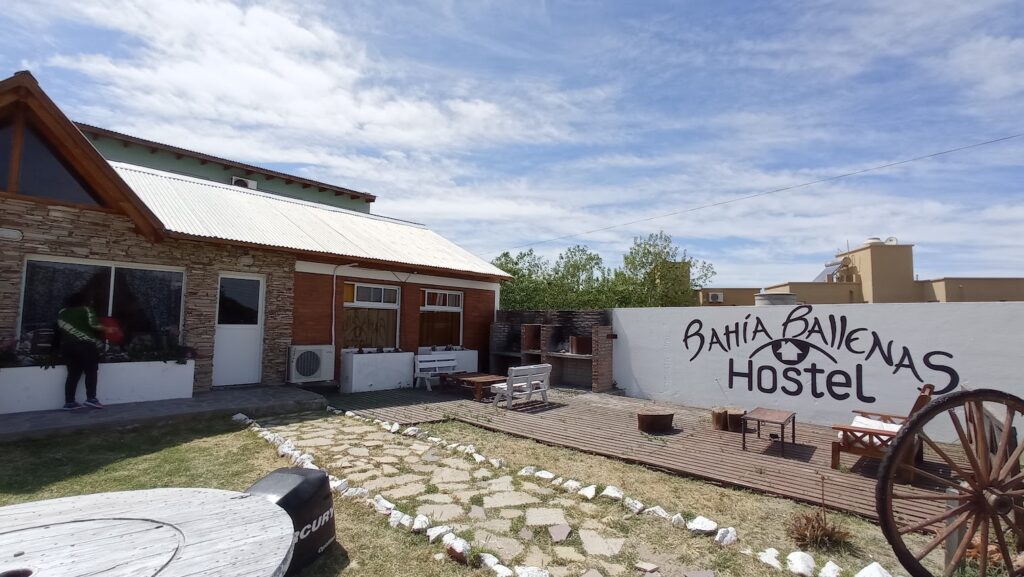
I personally stayed at Bahia Ballenas, and this may just be one of the best hostels I’ve ever stayed at. The owner was a very friendly chap who actively dished out advice about what to do on the peninsula, arranged a transfer for me and a few other guests to the east coast, put together a barbecue one of the nights and let me borrow his mountain bike for a day. Truly hospitality of the highest order. As well as that, the kitchen was well-equipped, the beds were comfy and the hostel’s small size within a one-storey house created a community atmosphere between all the guests.
Where to eat in Puerto Piramides
Small grocery shops stock basic goods, drinks and snacks, and there is a slightly larger one on the eastern end of town that has a wider selection of foodstuffs. Prices are also quite reasonable considering the isolated location. As for cafes, there is one by the whale watching agencies called El Viento Viene (The Wind Comes) in which I had an amazingly rich coffee and some great alfajores, an Argentinian speciality in which two cookies are stuck together with cream or dulce de leche. Bar La Estacion is a great option for dinner, with their nautical decor and strong beer on tap.
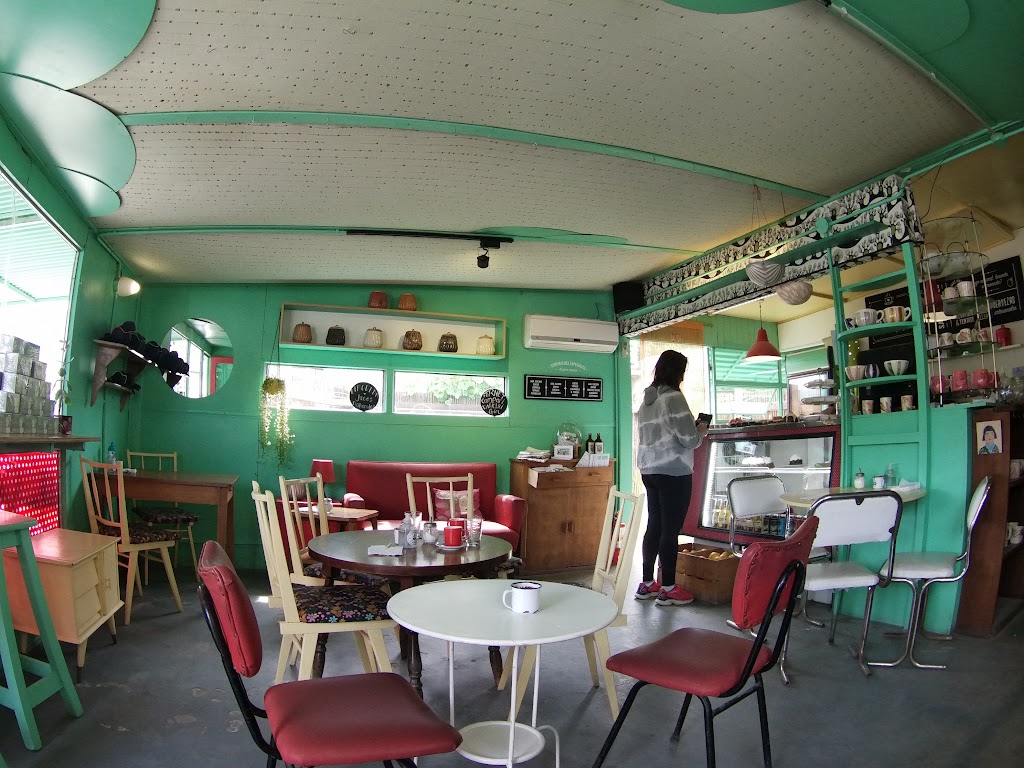
Getting to Peninsula Valdes from Puerto Madryn
Buses from Puerto Madryn leave for Puerto Piramides every day, though you should know that there is only one daily departure on weekends. Tickets can only be bought one hour in advance. Once you get to the Peninsula’s entrance, the bus will stop for passengers to pay their entry fee at the rangers’ hut. You’ll only pay this fee for each time you enter, which makes staying in Puerto Piramides the best way to appreciate all the peninsula has to offer. As for coming back, Puerto Piramides’ bus terminal has no ticket offices, but you can buy directly from the driver.
If you’re driving this will be slightly easier, though just remember to stop at the checkpoint.
Getting around Peninsula Valdes (+ How to get to Orca sites)
Roads in the peninsula east of Puerto Piramides aren’t paved, though car rental agencies in Puerto Madryn will generally be ok with you driving around the peninsula since most of their customers do so. Just bear in mind that there’s no phone signal outwith Puerto Piramides.
For those who can’t drive, Puerto Piramides has a transfer service to the east coast sites. Try to go on a day when others are, so that you can split the cost (this is also why I’d recommend Bahia Ballenas, since the owner had had a few people asking about transfers that day and so worked to group us together).

Cycling is a possibility, but you should not try to cycle to any of the east coast sites. The peninsula is much larger than it seems on the map, you’ll likely deal with intense heat and strong headwinds, and road surfaces either alternate between soft gravel that will feel like cycling through sand or bumpy tractor tracks that cover the breadth of the road in some parts.



